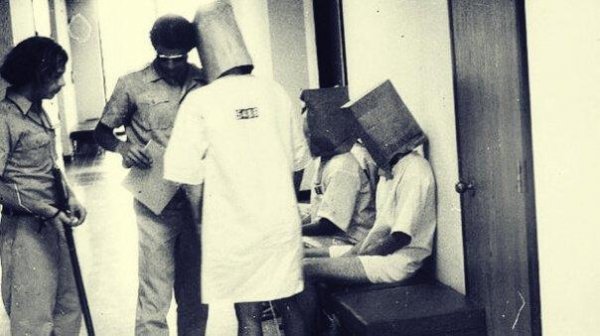The Lucifer Effect, or Why We Can Commit Evil Acts


Written and verified by the psychologist Valeria Sabater
The Lucifer effect can happen in any setting of our daily life. It is a transformation. It can make an apparently normal, good and well-educated person capable of committing atrocious acts. They are people who have no disorder or traumatic past yet find themselves dehumanized by the powerful influence of a particular situation.
Every good criminologist who knows some sociology will tell us that evil is not a kind of “fantasy” or universal term that exists as a mere antonym of “goodness”. It exists in context: a particular social situation and psychological mechanisms related to it.
“The line between good and evil is permeable and almost anyone can be induced to cross it when pressured by situational forces..”
-Phillip Zimbardo-
One famous example of the Lucifer effect is the Salem witch trials when the community of the time was gripped by religious fanaticism, puritanism, and collective hysteria. Another good example is the now famous television character Walter White, from the series “Breaking Bad“.
Anthropologists Alan Page Fiske and Tage Shakti point out that in the Lucifer effect, someone initiates a series of violent acts based on what they perceive to be right. That is, what they are doing, as atrocious as it is, is justified by the complex personal situation and social context. However, we must bear in mind that no violence is ever “virtuous”.
It could be that at a given moment, due to certain social and structural circumstances, a person feels the need or obligation to cross the line towards evil or cruelty. This is the Lucifer effect. Above everything else, morality is a key concept here. In short, morality acts as a decoy for our memory: there is logic or integrity beyond the pressure of the environment or despair.

The Lucifer Effect and Philip Zimbardo’s study
It is the night of April 28th, 2004. Most people in America are finishing their dinner and sitting down in front of the television to watch the program “60 Minutes”. Something changed that day. The television network invited them to see something that many were not prepared for.
They broadcast images of the Abu Ghraib prison in Iraq, where a group of American soldiers (men and women) sodomize, torture and rape the Iraqi prisoners in the most abominable and humiliating ways.
One of the people who watched those scenes, with immense dread, was the well-known psychologist Philip Zimbardo. But, for him those acts were not new, they were not strange, and they were not inexplicable. American society, however, saw it as a violation of their previously held beliefs.
Suddenly, those who they considered “good” were now bad. Saviors turned into torturers. Maybe they had overestimated the capabilities of the American military?
The 1971 Zimbardo experiment
After the publication of the photographs, those 7 US guards were charged and subsequently brought to trial. Despite everything, Dr. Philip Zimbardo thought it necessary to go to the trial as an expert witness to explain what happened.
In fact, before going to the trial, he made one thing very clear. The evil that had germinated in that prison was the effect of the Bush administration and a policy that clearly facilitated the Lucifer effect.
One of the reasons he felt obliged to collaborate in the trial was that he himself had experienced a situation very similar to that of Abu Ghraib prison. In 1971 he conducted an experiment at Stanford University, the famous Stanford prison experiment. He divided two groups of undergraduate students into “guards” and “prisoners.”
After a few weeks, Zimbardo witnessed unexpected and unimaginable levels of cruelty. Liberal university students, known for their altruism, kindness and sociability, became sadists. And simply for taking on the role of “guard.” Finally, it got to such an extreme that it forced Zimbardo to stop the experiment.

The Lucifer effect and its psychological processes
What happened at Stanford University with that experiment seemed to be a clear premonition of what would happen years later in the Abu Ghraib prison. Dr. Zimbardo wasn’t trying to exonerate or justify the accused soldiers’ actions. He certainly wasn’t making them into victims. Instead, he wanted to offer a scientific explanation of how certain circumstances can completely transform our actions.
These are the psychological processes that Zimbardo identified that make up the Lucifer Effect:
- Conformity with a group. Solomon Asch theorized that certain social pressures sometimes drive us to carry out behaviors that may go against our values. For what? Acceptance.
- Obedience of authority, by Stanley Milgram. This phenomenon is common, for example, in groups with a military or police hierarchy. Here, a good portion of its members are capable of committing violent acts if they are justified or ordered by people with a higher ranking.
- Moral disconnection by Albert Bandura. People have their own moral codes and value systems. However, sometimes they do mental “pirouettes” even if it’s totally opposed to their principles. It may even get to the point where they see something that’s morally unacceptable as correct.
- Environmental factors. Dr. Zimbardo learned that these soldiers worked in 12 hour shifts 7 days a week — over 40 days without breaks. In fact, they slept in the cells. Also, the facilities were in poor condition, with mold, blood stains and human remains on the walls. They were suffering up to 20 mortar attacks per week as well.

Can we prevent it?
To conclude, Zimbardo explains in his book “The Lucifer Effect” that dehumanization was inevitable. The situational factors, contextual social dynamics and psychological pressure can feed evil in any of us. We carry that “seed” in us, whether we like it or not. However, we can counteract that perverse side with determination, integrity, and clear limits. We can use these things to keep ourselves from forgetting who we are.
The Lucifer effect can happen in any setting of our daily life. It is a transformation. It can make an apparently normal, good and well-educated person capable of committing atrocious acts. They are people who have no disorder or traumatic past yet find themselves dehumanized by the powerful influence of a particular situation.
Every good criminologist who knows some sociology will tell us that evil is not a kind of “fantasy” or universal term that exists as a mere antonym of “goodness”. It exists in context: a particular social situation and psychological mechanisms related to it.
“The line between good and evil is permeable and almost anyone can be induced to cross it when pressured by situational forces..”
-Phillip Zimbardo-
One famous example of the Lucifer effect is the Salem witch trials when the community of the time was gripped by religious fanaticism, puritanism, and collective hysteria. Another good example is the now famous television character Walter White, from the series “Breaking Bad“.
Anthropologists Alan Page Fiske and Tage Shakti point out that in the Lucifer effect, someone initiates a series of violent acts based on what they perceive to be right. That is, what they are doing, as atrocious as it is, is justified by the complex personal situation and social context. However, we must bear in mind that no violence is ever “virtuous”.
It could be that at a given moment, due to certain social and structural circumstances, a person feels the need or obligation to cross the line towards evil or cruelty. This is the Lucifer effect. Above everything else, morality is a key concept here. In short, morality acts as a decoy for our memory: there is logic or integrity beyond the pressure of the environment or despair.

The Lucifer Effect and Philip Zimbardo’s study
It is the night of April 28th, 2004. Most people in America are finishing their dinner and sitting down in front of the television to watch the program “60 Minutes”. Something changed that day. The television network invited them to see something that many were not prepared for.
They broadcast images of the Abu Ghraib prison in Iraq, where a group of American soldiers (men and women) sodomize, torture and rape the Iraqi prisoners in the most abominable and humiliating ways.
One of the people who watched those scenes, with immense dread, was the well-known psychologist Philip Zimbardo. But, for him those acts were not new, they were not strange, and they were not inexplicable. American society, however, saw it as a violation of their previously held beliefs.
Suddenly, those who they considered “good” were now bad. Saviors turned into torturers. Maybe they had overestimated the capabilities of the American military?
The 1971 Zimbardo experiment
After the publication of the photographs, those 7 US guards were charged and subsequently brought to trial. Despite everything, Dr. Philip Zimbardo thought it necessary to go to the trial as an expert witness to explain what happened.
In fact, before going to the trial, he made one thing very clear. The evil that had germinated in that prison was the effect of the Bush administration and a policy that clearly facilitated the Lucifer effect.
One of the reasons he felt obliged to collaborate in the trial was that he himself had experienced a situation very similar to that of Abu Ghraib prison. In 1971 he conducted an experiment at Stanford University, the famous Stanford prison experiment. He divided two groups of undergraduate students into “guards” and “prisoners.”
After a few weeks, Zimbardo witnessed unexpected and unimaginable levels of cruelty. Liberal university students, known for their altruism, kindness and sociability, became sadists. And simply for taking on the role of “guard.” Finally, it got to such an extreme that it forced Zimbardo to stop the experiment.

The Lucifer effect and its psychological processes
What happened at Stanford University with that experiment seemed to be a clear premonition of what would happen years later in the Abu Ghraib prison. Dr. Zimbardo wasn’t trying to exonerate or justify the accused soldiers’ actions. He certainly wasn’t making them into victims. Instead, he wanted to offer a scientific explanation of how certain circumstances can completely transform our actions.
These are the psychological processes that Zimbardo identified that make up the Lucifer Effect:
- Conformity with a group. Solomon Asch theorized that certain social pressures sometimes drive us to carry out behaviors that may go against our values. For what? Acceptance.
- Obedience of authority, by Stanley Milgram. This phenomenon is common, for example, in groups with a military or police hierarchy. Here, a good portion of its members are capable of committing violent acts if they are justified or ordered by people with a higher ranking.
- Moral disconnection by Albert Bandura. People have their own moral codes and value systems. However, sometimes they do mental “pirouettes” even if it’s totally opposed to their principles. It may even get to the point where they see something that’s morally unacceptable as correct.
- Environmental factors. Dr. Zimbardo learned that these soldiers worked in 12 hour shifts 7 days a week — over 40 days without breaks. In fact, they slept in the cells. Also, the facilities were in poor condition, with mold, blood stains and human remains on the walls. They were suffering up to 20 mortar attacks per week as well.

Can we prevent it?
To conclude, Zimbardo explains in his book “The Lucifer Effect” that dehumanization was inevitable. The situational factors, contextual social dynamics and psychological pressure can feed evil in any of us. We carry that “seed” in us, whether we like it or not. However, we can counteract that perverse side with determination, integrity, and clear limits. We can use these things to keep ourselves from forgetting who we are.
This text is provided for informational purposes only and does not replace consultation with a professional. If in doubt, consult your specialist.







